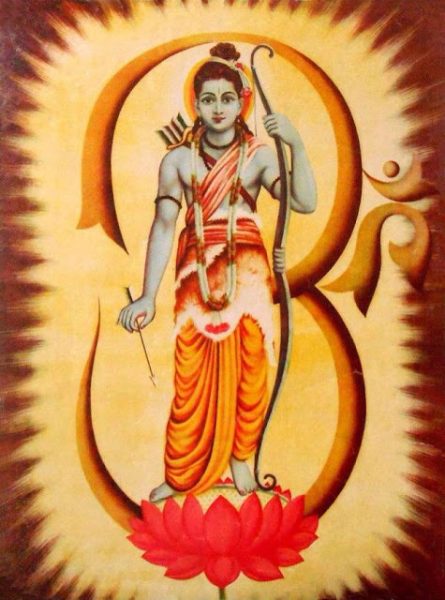Thus for example it takes up the question asked by Vali who asks Rama as to why he killed him hiding from behind a tree, especially since Vali had no personal enmity with him. Rama answers explaining the subtle nature of dharma explaining that in the forest he is wandering as s servant of his brother Baharat who is right now the King. Therefore to maintain law and order of a just society he must punish the aggressors who rule along the principle of might is right. Being a Kshatriya also it is his duty to protect the righteous. In this case Vali was clearly the unjust aggressor against his own brother Sugriva. He had besides married his sister-in-law who should have been rather looked upon as sister or mother. Hence his killing of Vali is justified. When asked about why in the hiding, Rama clearly states that he has shot at him as a hunter would to a wild animal, since Vali has been like an animal in all his behavior. Besides it was impossible for anyone to kill Vali in a frontal combat, leaving no other option than to kill him thus. Yet, and here comes the final verdict. Rama accepts inwardly that though he did what he did due to exigency of time and circumstances it is not the ideal way. Hence in his next incarnation as Krishna he chooses to be killed accidentally by Vali’s son Angad, now born as a hunter who shots an arrow from the hiding mistaking Krishna’s Feet for a deer’s eye. The circle of dharma is completed.
 Even though Rama is none else but the Divine incarnate, he at first identifies himself as the servant of the then King of Ayodhya, and later as an upholder of dharma takes upon himself the consequences of the act thereby respecting the cosmic law. The only other blot on his rather impeccable and noble character is the banishment of his spouse Sita at the instance of doubt raised by a commoner. Leaving aside the symbolism part, here again we see Rama setting the highest standards of dharma by willfully binding himself to the then law of the land even as a commoner had to rather than conveniently overrule the law by his regal powers. And yet, even though his banishment is to uphold the Rajdharma (The code of governance of a king) he refuses to remarry and even suffers in silent agony for Sita.
Even though Rama is none else but the Divine incarnate, he at first identifies himself as the servant of the then King of Ayodhya, and later as an upholder of dharma takes upon himself the consequences of the act thereby respecting the cosmic law. The only other blot on his rather impeccable and noble character is the banishment of his spouse Sita at the instance of doubt raised by a commoner. Leaving aside the symbolism part, here again we see Rama setting the highest standards of dharma by willfully binding himself to the then law of the land even as a commoner had to rather than conveniently overrule the law by his regal powers. And yet, even though his banishment is to uphold the Rajdharma (The code of governance of a king) he refuses to remarry and even suffers in silent agony for Sita.
But apart from these two stories, which have their own justification given the age, context and the background, the image of Rama long imprinted upon the Indian psyche is of the ideal Kshatriya strong and fierce in combat yet gentle in demeanor, fearless in battle yet tender in feelings when it comes to his dealings with the different segments of society, wise in his counsels and yet humble in his approach towards knowledge. He is ready to gather pearls of wisdom from all the sages whom he meets on the way during his sojourn in the forest and even does not spare his younger brother Lakshmana to seek the ways of good governance from Ravana before he dies even as his arch rival is fallen on the ground during his final moments. His deep compassion for the lowly and the outcaste, Guhak, his upholding of friendship with the Vanra Sugriva, his redemption of Ahilya whom her husband the society had abandoned as a sinner, his treatment of one and all, whether it be eating from the hands of an ordinary woman Shabari or doing the last rites for the vulture king Jatayu sowed the seeds of a divine socialism in the Indian mind and opened the path towards an ideal society known till date as Ramarajya.
The key element of this perfect society being that the King held himself responsible for all that happened in his kingdom including the various forms of sufferings and diseases in his subjects. His renunciation of the kingdom to uphold his father’s or rather a king’s promise given to his wife is matched only with his valiant stand to rescue the daughter of Janaka from the clutches of Ravana. Here we can see the true meaning of renunciation which is not an outer abandonment of life and action but to act always, not under the impulsion of ego and desires, but to uphold the dharma. In the single persona and figure of Rama we see a perfect symbol of the high and noble Aryan type, the heroic humanity that shrinks not from any battle whether it be inner or outer. But his battles are never for the ostentatious expansion of ambition but for the expansion of dharma. The conquest is as much a dharma as everything else. In him we see the meeting of the triumvirate of manhood in the form of wisdom, strength and love knit together around the ideal of dharma.



